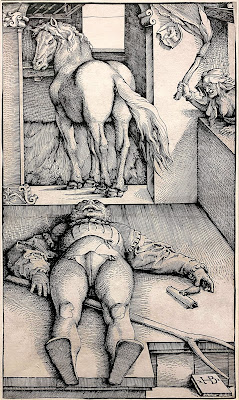Starting in 1503, Hans Baldung Grien learned the trade at the atelier of Albrecht Dürer in Nuremberg. At that time, many men were called John, so some art historians claim that Hans got the byname Grien distinguishing him from his colleagues in Dürer's workshop because he loved the color green.
 |
| Self-Portrait (1502) |
"The stained glass is from the Löffelholz Window at the Nuremberg parish church Saint Lorenz. Here, Baldung worked with the important Nuremberg workshop of Veit Hirschvogel, the Elder, whereby he probably provided the design and was also involved in the execution of the work. Magnificent details such as the ermine-trimmed cloak and the kneeling king's hat, the goldsmith's objects serving as gifts, as well as the colorful dawn making the sky glow are worth a special mention."
 |
| The Holy Family in the Room with Five Angels (around 1507) |
"Baldung probably created this devotional picture towards the end of his Nuremberg years. The richly detailed interior offering a view of a river landscape is based on Dutch models. An angel presents Child Jesus with a pear, a symbol for overcoming the original sin. Mary's thoughtful expression is explained by the knowledge of the suffering her son is about to endure. The box in the foreground, reminiscent of a sarcophagus, could also be a hint."
Being a well-known artist by 1512, Baldung moved to Freiburg and later, in 1519, to Strasbourg.
 |
| Hans painted himself on the right on his altarpiece, proudly wearing a red beret. |
The Freiburg Minster Church enshrines Hans's most frivolous altarpiece showing Christ half-naked in his red cape crowning his mother as the Heavenly Queen.
 |
| And Hans placed the following signature: John Baldung, called Grien, originating from Gmünd, created it with the help of God and by his own strength. |
 |
| Mother of God with the Sleeping Child (1514) |
"Maria and the Child are set off from the abstract bright red background in a very plastic and precisely modeled way. Both the unusual red background and the death-like sleep of the Child go back to early Christian models. A cryptic dating of the painting has led to various interpretations. Recent infrared photographs show a Gothic four, indicating that this painting was created in Baldung's Freiburg period."
 |
| One of Freiburg's patrons, St. Lambert, with the city's coat of arms, i.e., St. George's cross painted on the glass around 1513 |
 |
| The inscription reads, "A Happy New Year to the Canons " (1514) |
When the Reformation was established at Strasbourg, the commissions for paintings with religious motives dried up, and many artists ended in misery. Not so Hans the Grien. He delivered not only Madonnas but witches too.
 |
| Two Witches (1523) |
Soon some of Hans's male clients interpreted his paintings of Madonnas as lascivious Eves instead.
But Baldung was critical of those lewd old rich white men too.
 |
| An unequal couple (around 1527) |
As always, money is involved in those deals.
"Here, the usual humorous tone for depictions of odd couples has given way to sober thoughtfulness. The pale, possibly pregnant woman is not a cunning seductress but stares sadly into space. Is the money in her lap the payment of the vital old man who has "bought" a young wife? This small painting interprets the old theme in a completely new way with high sensitivity and art of representation."
 |
| Birth of Christ (1539) |
Joseph looks somehow suspicious. Has he realized that the newborn Child in front of him is not his son?
 |
| The Bewitched Groom (around 1534) |
"It is also possible that reference is made to a popular legend. It tells of a robber baron who made a pact with the devil. When he hid from the devil in the disguise of a groom, he was killed by a horse. If the reclining figure is not dead, the strange scene may arise from his dreams, but what does Baldung's person have to do with it? The mysteriousness of the scene is the exceptional quality of the woodcut, which is still fascinating today."
 |
| Self-portrait at the age of 49 years (woodcut, 1534?) |
While the name Dürer dominated the art scene in Germany around 1500, Hans Baldung Grien definitely is on par artistically.
N.B.: The long texts in italics are translations of accompanying explanations at the Karlsruhe exhibition.
*







No comments:
Post a Comment